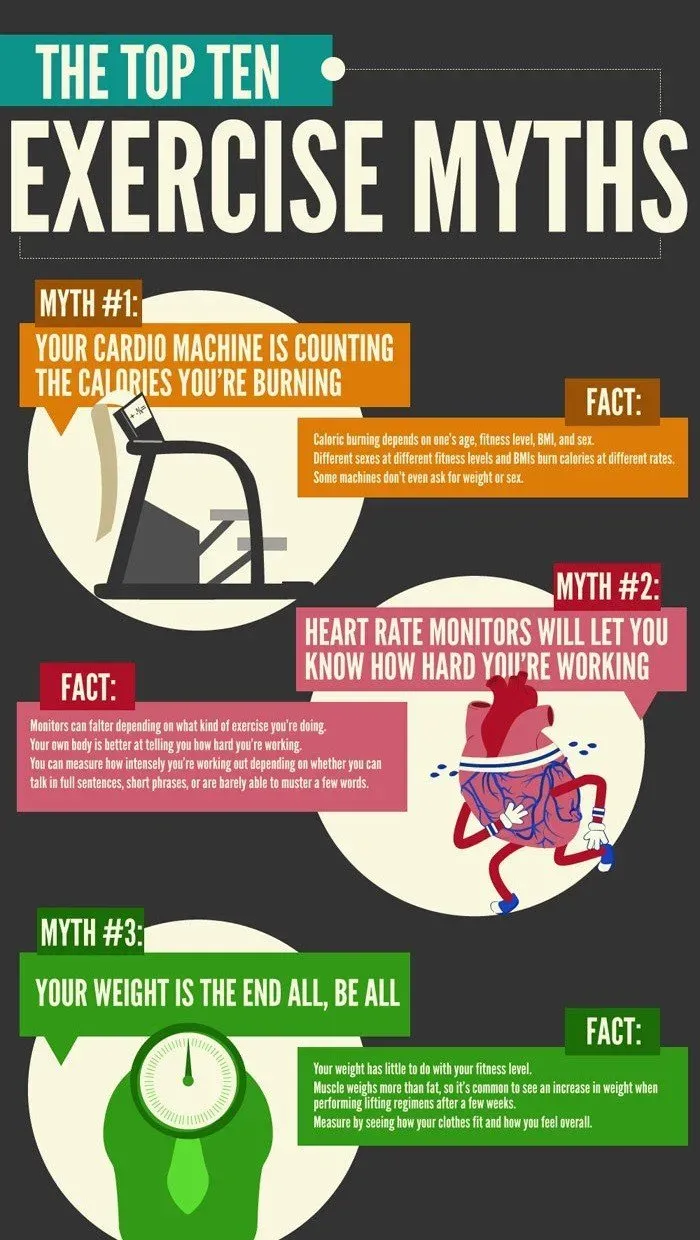Fitness Myths Busted: What You Really Need to Know
In the fitness world, myths abound, often misleading enthusiasts and newcomers alike about how to achieve optimal health. Among these fitness myths, one of the most predominant is that cardio alone guarantees weight loss, overshadowing the equally important role of strength training. Understanding these myths about exercise is crucial for anyone looking to enhance their fitness journey and develop a healthy lifestyle. Misconceptions like lifting weights making you bulky can deter individuals, particularly women, from reaping the benefits of strength training. By debunking these fitness myths and exploring the facts behind effective workouts, you can create a balanced approach to fitness that works best for you.
When navigating the vast landscape of health and wellness, it’s easy to stumble upon common misconceptions that can hinder personal progress. Many people encounter a variety of untruths, from erroneous beliefs about the effectiveness of cardiovascular routines to misunderstandings surrounding resistance training. These inaccuracies can lead to confusion about maintaining a wholesome lifestyle, resulting in misguided fitness regimens. Therefore, it’s vital to differentiate fact from fiction, empowering yourself with accurate information to foster both mental and physical well-being. By understanding the reality behind common fitness misconceptions, you’ll be better prepared to achieve and maintain your health aspirations.
The Truth About Cardio: Essential for Weight Management?
Cardiovascular exercise has long been touted as the cornerstone of any weight loss regimen, often leading beginners to believe that it must be the only focus in their fitness routine. However, while cardio exercises such as running, swimming, and cycling certainly burn calories effectively, they are not a standalone solution for losing weight. In fact, the incorporation of strength training into a fitness routine plays an equally vital role. Strength training increases muscle mass, which in turn elevates your resting metabolic rate, allowing your body to burn more calories throughout the day. A balanced approach that includes both cardio and strength training is essential for effective weight management.
Additionally, many people overlook the psychological benefits of combining different forms of exercise. Engaging in varied workouts helps to prevent boredom and sustain motivation. Studies indicate that individuals who incorporate both cardiovascular and strength training are more likely to adhere to their exercise programs long term. Therefore, rather than fixating solely on cardio for weight loss, it is crucial to embrace a diversified exercise regimen that supports overall health and fitness.
Busting Weight Loss Myths: Why Strength Training Matters
One prevalent myth regarding weight loss is that strength training is secondary to cardio. This misconception often stems from a misunderstanding of how the body burns fat and builds muscle. Contrary to popular belief, strength training is not just about lifting weights to bulk up; it is an effective way to increase muscle tone and boost metabolic activity. Studies consistently show that muscle tissue burns more calories than fat even at rest, making strength training a powerful ally in the quest for fat loss.
Furthermore, strength training can help combat some of the pitfalls of traditional dieting. By building and maintaining muscle mass, your body can preserve its metabolic rate during weight loss, a time when many individuals experience a natural slowdown in metabolism. As such, the combination of strength training and cardio creates a well-rounded workout routine that supports lasting weight management and promotes a healthier, more active lifestyle.
Myths About Exercise: Understanding the Role of Fat Loss
Many individuals cling to the myth that targeted fat loss, or spot reduction, is achievable through specific exercises. This notion is particularly appealing for those looking to trim down specific areas, such as the abdomen or thighs. However, research clearly indicates that fat loss occurs systemically rather than site-specifically. The most effective way to reduce overall body fat is through a combination of high-quality nutrition and a comprehensive exercise program that emphasizes full-body workouts.
Additionally, varied routines that include both cardio and strength training help to increase the likelihood of fat loss by promoting higher overall caloric expenditure. Incorporating functional movements that engage multiple muscle groups ensures that workouts are not only more effective but also more enjoyable. Ultimately, understanding the facts about fat loss can empower individuals to approach their fitness journeys with realistic expectations and an informed strategy.
Sweating: A True Indicator of Workout Effectiveness?
One common misconception is that the amount you sweat during a workout is directly correlated to the workout’s intensity and overall effectiveness. Many believe that if they’re not dripping with sweat, they’re not gaining benefits from their physical activity. However, this is a misleading belief. Factors such as temperature, humidity, and individual differences in physiology can all impact how much you sweat, making it an unreliable measure of workout efficiency.
Instead, it’s more beneficial to judge workout effectiveness through metrics like heart rate, perceived exertion, and performance improvements over time. Training at varying intensities and incorporating interval training can yield significant cardio benefits without an excessive reliance on sweating as an indicator. Understanding this can help individuals tailor their fitness routines to be effective without being misled by superficial signs of effort.
Stretching: To Do or Not To Do Before Workouts?
A widely held belief is that static stretching before workouts is essential for preventing injury and improving performance. However, emerging research challenges this notion, suggesting that static stretching may do more harm than good prior to physical activity. Static stretching, which involves holding a position for an extended period, can temporarily reduce muscle strength and limit performance, detracting from a workout.
Instead, dynamic stretching, which involves controlled movements that gently take you to the limits of your range of motion, is increasingly recommended for warm-ups. This type of stretching prepares the muscles and joints for the activities ahead, therefore enhancing your performance while reducing the risk of injury. Incorporating dynamic stretches into your pre-workout routine can significantly improve your overall workout efficacy.
Fad Diets: A Shortcut to Success or a Slip Up?
The allure of fad diets often promises quick results, preying on individuals’ desires for rapid weight loss without long-term commitment. However, these diets frequently lack nutritional balance and can lead to unsustainable eating habits. Research indicates that while people may see immediate results on these restrictive diets, they often face the consequences of ‘yo-yo dieting,’ which can ultimately lead to weight gain and detrimental effects on metabolic health.
A sustainable approach to weight management involves incorporating whole foods, education about nutrition, and fostering a healthy relationship with food rather than adhering to transient diet trends. Emphasizing balanced meals that fit into one’s lifestyle is key, as this offers a more sustainable and healthier way to lose weight and maintain it in the long run.
Common Misconceptions About Healthy Lifestyles
Many misconceptions surrounding a healthy lifestyle can hinder individuals from making positive changes. One such myth is that living healthily requires severe restrictions or elimination diets. In reality, a healthy lifestyle is more about moderation and balance rather than deprivation. Individuals can achieve health goals by enjoying a wide variety of foods in proportion to their body’s needs, emphasizing whole, nutrient-dense foods, and maintaining regular physical activity.
Additionally, it’s common to believe that all physical activity must be strenuous to be beneficial. This is not true; incorporating low-impact activities such as walking, yoga, or cycling into your routine can also greatly contribute to overall health. Understanding that consistency and enjoyment in fitness activities are more impactful than intensity can help foster a lifelong commitment to health.
The Importance of Rest in Your Fitness Journey
Many fitness enthusiasts fall into the trap of believing that more exercise equates to better results, disregarding the importance of rest and recovery. Overtraining can lead to burnout, increased injury risk, and negative impacts on mental and physical health. The body requires time to recover, repair, and grow stronger, making rest days just as essential as workout days.
Incorporating rest days into your routine allows your body to replenish energy stores, reduce muscle soreness, and ultimately improve performance. Understanding this key principle of fitness can make all the difference in achieving long-term goals without sacrificing health or motivation. Adequate rest combined with a balanced exercise routine ensures continuous progress and helps to maintain a consistent level of enthusiasm for fitness.
Finding Balance: The Key to a Successful Fitness Regimen
In the journey towards health, finding a balance between various forms of fitness activity is essential. Many individuals tend to focus on one type of exercise, neglecting the benefits that a holistic approach can provide. A successful fitness regimen incorporates elements of cardiovascular training, strength training, flexibility, and rest, ensuring well-rounded development.
Moreover, balance entails listening to your body and adjusting workouts based on how you feel. Incorporating a variety of exercises not only prevents burnout but also keeps workouts engaging and enjoyable. By recognizing the value of a balanced approach, individuals can foster a healthier relationship with fitness, successfully achieve their goals, and ultimately maintain a sustainable healthy lifestyle over time.
Frequently Asked Questions
What are some common weight loss myths that people believe?
Common weight loss myths include the idea that you can lose weight quickly through fad diets, that cardio alone is enough to lose weight, and that you need to sweat to have an effective workout. Understanding the facts, such as the importance of combining strength training with cardiovascular exercise and focusing on balanced nutrition, can help dispel these myths.
Is it true that strength training will make me bulky?
This is a widespread misconception. Many believe that strength training will lead to bulkiness, especially women. In reality, lifting weights can help improve muscle tone and strength without significantly increasing muscle size, as women typically lack the testosterone required for large muscle growth.
Can I spot reduce fat with targeted exercises?
No, spot reduction is a myth. Fat loss occurs throughout the body uniformly, and no specific exercise will target fat loss in just one area. A balanced approach that includes full-body workouts and proper nutrition is essential to losing fat effectively.
Do I need to sweat a lot to have a good workout?
Sweating is not a reliable indicator of workout effectiveness. Factors like individual sweat rates and environmental conditions affect how much you sweat. It’s more important to focus on your workout intensity and heart rate to gauge effectiveness.
Should I stretch before every workout?
Many still believe static stretching before workouts is crucial, but recent studies suggest it may hinder performance. Dynamic stretching or warming up with movement is preferred to effectively prepare your muscles for exercise.
Are fad diets a good long-term weight loss solution?
Fad diets often promise rapid results but are generally unsustainable and can lead to yo-yo dieting. Long-term weight loss is best achieved through balanced nutrition and sustainable lifestyle changes.
Is cardio exercise the best way to stay fit?
While cardio exercise is important for heart health and calorie burning, it’s just one part of a balanced fitness regime. Incorporating strength training is equally important for overall health and muscle maintenance.
Can I build muscle while losing weight?
Yes, it is possible to build muscle while losing weight. By combining a well-structured strength training program with proper nutrition, including adequate protein intake, you can achieve both goals simultaneously.
Do women need to train differently than men to gain strength?
The principles of strength training apply to both genders. However, women may face different societal myths and are sometimes underestimated in their strength training abilities. Both men and women can benefit from similar training approaches tailored to individual needs.
Is it necessary to follow a strict diet to achieve a healthy lifestyle?
Strict diets can be counterproductive and lead to unhealthy eating patterns. A healthy lifestyle is best achieved through balanced eating habits, regular physical activity, and making sustainable choices rather than following rigid dietary restrictions.
| Fitness Myth | Explanation |
|---|---|
| Cardio is the Only Way to Lose Weight | Cardio is effective for weight loss, but combining it with strength training increases metabolism and promotes more effective fat loss. |
| Lifting Weights Makes You Bulky | Weightlifting can enhance muscle tone without bulking up, especially in women due to lower testosterone levels. |
| You Can Spot Reduce Fat | Fat loss occurs uniformly, requiring a full-body workout approach and proper nutrition. |
| You Need to Sweat to Have a Good Workout | Workout effectiveness should be based on heart rate and intensity, not the volume of sweat produced. |
| You Should Always Stretch Before a Workout | Static stretching can hinder performance; it’s better to do dynamic stretches as a warm-up. |
| Fad Diets are Effective Long-Term Solutions | Fad diets may offer quick results but lack nutritional balance; sustainable lifestyle changes are key for long-term success. |
Summary
Fitness myths can often derail individuals from achieving their health and fitness goals. The above information highlights critical misconceptions that many encounter in their journey. Understanding these myths helps in making informed decisions about exercise and nutrition. Integrating both cardio and strength training, addressing fat loss through comprehensive workouts, and avoiding the pitfalls of fad diets are foundational truths. By busting these fitness myths, you can pave a clearer path towards successful health management and improved fitness outcomes.
#FitnessMyths #BustedFitnessFacts #ExerciseTruths #HealthAwareness #WorkoutWisdom








